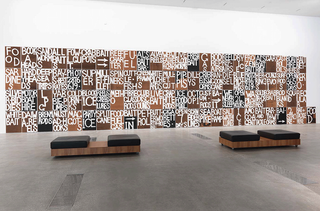Vale: Robert MacPherson

When Robert MacPherson AM died, on 12 November 2021, aged 84, Australia lost one of the most important artists of his generation. What made his contribution so remarkable was the way in which he translated the arcane languages and modes of contemporary art, particularly those of conceptualism and minimalism, into images and objects that formed a reply to everyday life. MacPherson was an ‘artist’s artist’, someone whose work commands immense respect among the contemporary art community but whose contribution to broader visual culture is perhaps less well known than it deserves to be. In a career spanning 50 years, he exhibited nationally as well as in the Sharjah Biennial in the United Arab Emirates and in group exhibitions in Lisbon, The Hague, Berlin, Sao Paolo and Singapore. More than that, he is extensively represented in our national and state gallery collections, including here in Queensland.
The Queensland Art Gallery | Gallery of Modern Art (QAGOMA) presented a career-spanning survey of MacPherson’s work, ‘The Painter’s Reach’, in 2015. The exhibition drew together the disparate strands of his interests, revealing an artist who spent his lifetime attending to notionally simple ideas, unfolding their endless complexity and potential for artistic enquiry. ‘The Painter’s Reach’ was about making works of art, the work of the ‘artist’ (in contrast to that of the ‘painter’) and the nature of ‘work’ itself. Often described as an auto-didact, MacPherson’s deep curiosity grew out of a fascination with rules and systems of all kinds; whether drawing on the history of art and social history, or the natural world and its taxonomies. His work was grounded in his biography: driven by a deep family connection to the land and his history as a cane field worker, a ringer, and a ship painter and docker. For MacPherson, art and life were inextricably joined.
Watch our time-lapse
Robert MacPherson, Australia 1937-2021 / 1000 FROG POEMS: 1000 BOSS DROVERS (“YELLOW LEAF FALLING”) FOR H.S. 1996–2014 / 2,400 sheets / Purchased 2014 with funds from the Queensland Art Gallery | Gallery of Modern Art Foundation, Paul and Susan Taylor, and Donald and Christine McDonald / Collection: Queensland Art Gallery | Gallery of Modern Art / © Estate of Robert MacPherson
1000 FROG POEMS: 1000 BOSS DROVERS

Robert MacPherson, Australia b.1937 / 1000 FROG POEMS: 1000 BOSS DROVERS (“YELLOW LEAF FALLING”) FOR H.S. 1996-2014 / Graphite, ink and stain on paper / 2400 sheets: 30 x 42cm (each) / Purchased 2014. Queensland Art Gallery | Gallery of Modern Art Foundation / Collection: Queensland Art Gallery | Gallery of Modern Art / © Robert MacPherson / View full image
‘The Painter’s Reach’ featured a work from the QAGOMA Collection that is unarguably one of MacPherson’s greatest achievements. Previously unseen at full scale, 1000 Frog Poems: 1000 Boss Drovers (‘Yellow Leaf Falling’) For H.S. 1996–2014 (illustrated), comprises 2400 A3 sketch-pad sheets bearing ink, pen and pencil portraits with cursive tributes to the Boss Drover in its margins. Each is drawn under the guise and hand of Robert Pene, a 10-year-old student at St Joseph’s Convent in Nambour, and dated 14 February 1947, MacPherson’s 10th birthday. They form an impossibly vast mosaic filled with the legendary men and women who drove cattle along the storied stock routes of the east coast. It is a work of brilliant archival research and artistic vision, whose epic and obsessive presence echoes and amplifies the unassuming love and precision invested in its making. Unsurprisingly, for MacPherson, it dignifies and memorialises humble but hard-working lives.
Mayfair: (Swamp rats)

Robert MacPherson, Australia 1937-2021 / Mayfair: (Swamp rats) Ninety-seven signs for C.P., J.P., B.W., G.W. & R.W. 1994-95 / Acrylic on masonite / 97 panels: 92 x 61cm (each); 370 x 1573cm or 556 x 1069cm (installed) / Purchased 1998 with a special allocation from the Queensland Government. Celebrating the Queensland Art Gallery’s Centenary 1895-1995 / Collection: Queensland Art Gallery | Gallery of Modern Art / © Robert MacPherson / View full image
Perhaps MacPherson’s most instantly recognisable works belong to his ‘Mayfair’ series, including QAGOMA’s Mayfair: (Swamp Rats) Ninety-Seven Signs for C.P., J.P., B.W., G.W. & R.W. 1994-94 (illustrated). It taps into the hand-painted blackboard roadside signs that appear on the verges of our regional highways –the white-on-masonite words that alert us to, for example, the block ice and bait to be found 500, then 250, metres along the road. This random and poetic and wonderfully ironic exploration of the amateur sign-maker’s art elevates the ‘Mayfair’ series beyond the vernacular and enables it to cross over into the lingua franca of the contemporary art world. This use of amateur roadside signs as a locus of meaning and a source of cultural knowledge, combined with his deep affection for the universality of language, gave him an unerring ability to define an Australian idiom.
Robert MacPherson lived and made art in Brisbane for five decades. He received an honorary Doctorate from Griffith University in 1995 and the Australia Council Emeritus Award in 1997. In 2015, he was recognised as a Queensland Great and honoured for his formative role in the history of Brisbane’s Institute of Modern Art. He was made a Member of the Order of Australia (AM) in 2020. Reflecting on his career, I feel bound to say that it’s all too easy to overlook rigorous and serious artists like MacPherson, whose work requires our close attention but refuses to seduce it. Vale Robert MacPherson, who pursued his artistic project with a certainty and a sense of purpose that consciously eschewed critical and public recognition. Now that we have lost him, it’s time we looked again at what he left behind.
Chris Saines CNZM is Director, Queensland Art Gallery | Gallery of Modern Art
Featured image: Robert MacPherson, Brisbane, 2014 / Photograph: M Sherwood © QAGOMA

